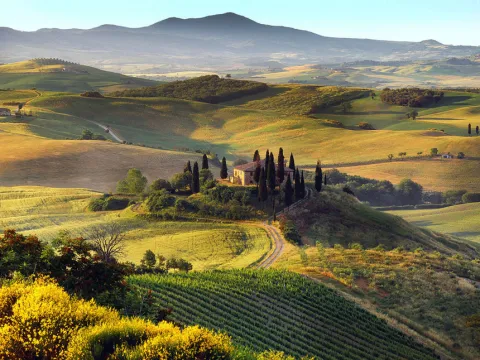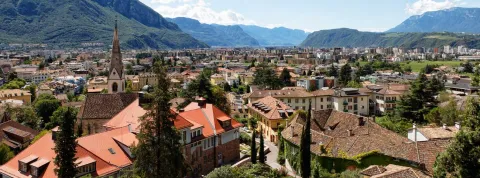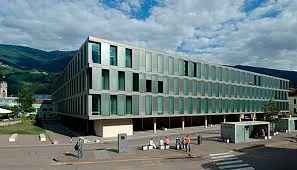FUoBB - Information on the Country and Region
The Country

The climate in Italy is highly diverse and can be far from the stereotypical Mediterranean climate depending on the location. Most of the inland northern areas of Italy (for example Turin, Milan and Bologna) have a continental climate often classified as Humid subtropical climate. The coastal regions have mild winters and warm and generally dry summers, although lowland valleys can be quite hot in summer.
Italy has been the home of many European cultures, such as the Etruscans and the Romans, and later was the birthplace of the universities and of the movement of the Renaissance, that began in Tuscany and spread all over Europe. Italy's capital Rome was for centuries the center of Western civilization; it also spawned the Baroque movement and seats the Catholic Church. Italy possessed a colonial empire from the mid-nineteenth century to the mid-twentieth century.
Pasta is the centerpiece of Italian eating and Italians take pride in their proficiency in the many and varied kinds of pasta making and cooking. Cheese and wine are a major part of the cuisine. Italian cuisine is now famous worldwide.
For more information about Argentina see sites such as en.wikipedia.org/wiki/Italy.
The City

Bolzano was ranked as having the second highest quality of life of Italian cities in 2007, with neighboring Trento topping the list.
The city's Italian-Austrian character, enhanced by the narrow cobblestone streets, Habsburg-era churches and pervasive bilingual signage give it the unique flavor of a city at crossroads between Italian and Austrian cultures. This and its natural and cultural attractions make it a renowned tourist destination.
Bolzano's climate is continental with very hot summers and very cold winters. In autumn and spring often blows the Föhn, a wind that comes from the northern part of the Alps. Whereas in Innsbruck it is a warm wind, in Bolzano there are moments when it's relatively warm and strong, and then the temperature may fall suddenly. The coldest month of the year is January (min -6.2°C/20.8°F, max 5.0°C/41.0°F, average 0.0°C/32.0°F), the warmest is July (min 15.1°C/59.2°F, max 29.4°C/84.9°F, average 22.0°C/71.6°F). The annual average is 11.6°C/52.9°F. The extreme records go from -17 to +40.
For more information about Bolzano, visit: en.wikipedia.org/wiki/Bolzano
The University

Fun Facts
- Italy is home to Europe’s only three active volcanoes: Etna, Stromboli, and Vesuvius.
- Vatican City, in Rome, is the smallest country in the world.
- Italy has 50 UNESCO World Heritage Sites, the most of any country in the world.
- Pizza was invented in Naples and dates back to 1860.
- Italy is the world’s largest exporter of wine.
- 14 billion espressos are consumed in Italy each year, and Italians use 3.7kg of coffee per capita.
- Italian Alessandro Volta invented the first battery in the 1800’s.
- The thermometer, the ice cream cone, the telephone, the typewriter and eyeglasses are Italian inventions.
- The piano hails from Italy.
- Famous Italian explorers include Christopher Columbus, Marco Polo, John Cabot, and Amerigo Vespucci.
Top 5 Places to Visit
- Strada delle Dolomiti (Dolomite Road): Bolzano is the western end of one of Europe's most spectacular driving routes, cited by UNESCO as a World Heritage Site for "some of the most beautiful mountain landscapes anywhere, with vertical walls, sheer cliffs, and a high density of narrow, deep, and long valleys." Along with the beauty of the glacial landscapes, UNESCO cited the geologic importance and fossil records of the 18 majestic snowcapped peaks.
- Parco Naturale Adamello Brenta: Parco Naturale Adamello Brenta is a wild and beautiful park encompassing more than 80 lakes and the vast Adamello glacier which was once home to the Alps' only brown bears.
- Castel Trauttmansdorff: You could give an entire day to these beautiful botanical gardens a little outside Merano. Exotic cacti and palms, fruit trees and vines, beds of lilies, irises and tulips all cascade down the hillside surrounding a mid-19th-century castle where Sissi – Empress Elisabeth – spent the odd summer.
- Muse Museum: A stunning new architectural work, care of Renzo Piano, houses this 21st-century science museum and cleverly echoes the local landscape. Curatorially, the museum typifies the city's brainy inquisitiveness, with highly interactive exhibitions that explore the Alpine environment, biodiversity and sustainability, society and technology. Highlights are an truely amazing collection of taxidermy, much of it suspended in a multi-story atrium, along with a fabulous experiential kids area and open working laboratories .
- Venice: Venice is the consummate magician. It makes marble palaces vanish into silent fogs, labyrinthine calli (streets) disappear at the whim of moody tides, and can even turn the most pedestrian of people into fantastical, masked creatures. Just like its world-famous Carnevale, Venice thrives on mystery and awe, from the secret passageways that riddle Gothic Palazzo Ducale, to the esoteric powers of the Basilica di Santa Maria della Salute, to the inexplicable radiance of Titian's Assunta altarpiece.
